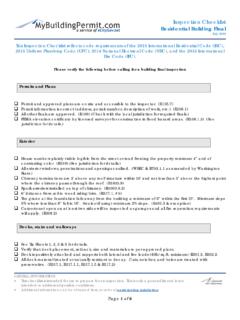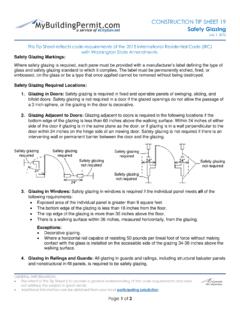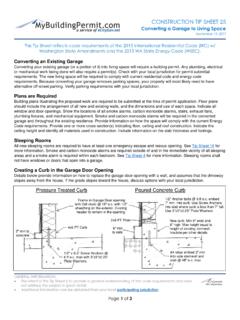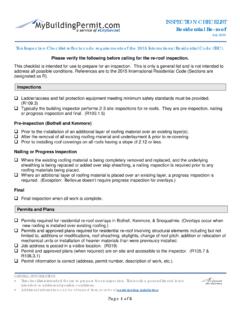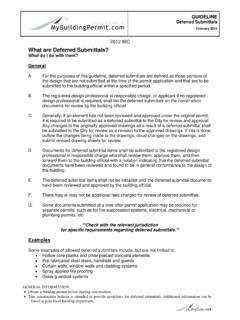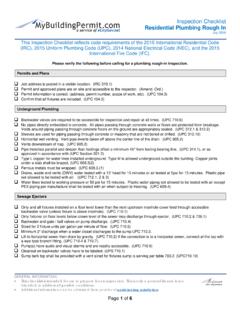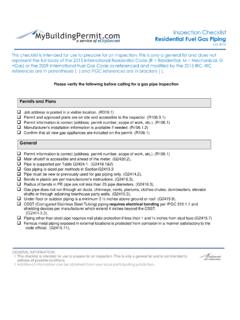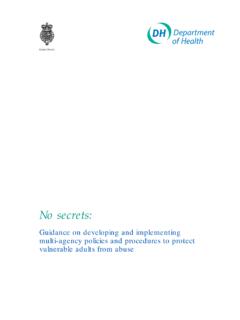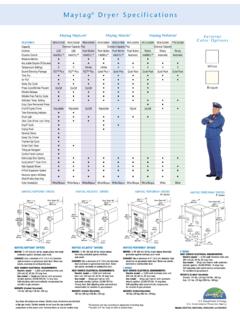Transcription of Smoke and carbon monoxide alarms must be provided in all ...
1 GENERAL INFORMATION: The intent of this Tip Sheet is to provide a general understanding of the code requirements and does not address the subject in great detail. Additional information can be obtained from your local participating jurisdiction. Page 1 of 2 CONSTRUCTION TIP SHEET 4 Residential Smoke / carbon monoxide alarms July 1, 2016 This Tip Sheet reflects code requirements of the 2015 International Residential Code (IRC) with Washington State Amendments and the 2013 edition of NFPA 72. Smoke and carbon monoxide alarms must be provided in all required locations and must be: audible in all parts of the house installed per manufacturer's instructions New Houses (IRC R314 & R315) Smoke alarms and carbon monoxide alarms are required and must be connected to the main electrical system with battery backup.
2 Existing Houses (IRC & ) Smoke alarms are required for any addition or repair work requiring a building permit, except exterior surface work such as re-roofing, siding, deck or porch additions, and window replacement. alarms will not be required to be interconnected and hard wired where the permit work does not require the removal of interior wall or ceiling finishes unless there is an attic, crawlspace, or basement available where access is provided . carbon monoxide alarms are required in all new and existing homes, apartments, condominiums, and other multi-family units. Required Locations Smoke alarms shall be located in each sleeping room and in napping areas in a family home child care.
3 Smoke alarms and carbon monoxide alarms shall be located outside each sleeping area in the immediate vicinity of the bedrooms. Smoke alarms and carbon monoxide alarms shall be located on every floor level, including basements (does not include crawlspace and uninhabitable attics). In split level floor plans, at the upper level, provided there is no intervening door between adjacent levels and the lower level is less than a full story below the upper level A carbon monoxide alarm is required in a bedroom when a fuel-burning appliance is installed in the bedroom or its attached bathroom. A combination alarm (combined Smoke and carbon monoxide alarm) is acceptable in any required location.
4 Section View Plan View GENERAL INFORMATION: The intent of this Tip Sheet is to provide a general understanding of the code requirements and does not address the subject in great detail. Additional information can be obtained from your local participating jurisdiction. Page 2 of 2 Residential Smoke / carbon monoxide alarms Smoke Alarm Location Limitations Wall mounted alarms must be not more than 12 inches from the adjoining ceiling surface. Avoid placing alarms less than 3 feet from supply registers of a forced air heating or cooling system and do not place alarms in the direct airflow of the registers.
5 Avoid placing alarms within 3 feet horizontally from doors to bathrooms containing a bathtub or shower. Do not place alarms in spaces where temperatures may be above or below the alarm s operating temperature range. Do not place alarms within 3 feet of the blades of a ceiling fan. alarms in peaked or sloped ceilings must be within 3 feet of the peak, measured horizontally, but not in the highest 4 inches of the ceiling, measured vertically. (See figure below) Avoid placing alarms in dead air spaces. (See figure below) Smoke alarms near Cooking Appliances carbon monoxide Alarm Location Limitations A.
6 Photoelectric Smoke alarms must not be less than 6 feet from a permanent cooking appliance. B. Ionization Smoke alarms with an alarm- silencing switch must not be less than 10 feet from a permanent cooking appliance. C. Ionization Smoke alarms without an alarm- silencing switch must not be less than 20 feet from a permanent cooking appliance. Do not place alarms directly above or beside fuel-burning appliances. Do not place alarms in direct sunlight. Do not place alarms in low areas where children can reach. Do not place alarms behind curtains or any structure that might prevent carbon monoxide from reaching the sensor.
7
